Imagine this: You’ve poured your heart and soul into creating a fantastic website. You’ve spent countless hours crafting engaging content, only to find your site buried on the 10th page of Google’s search results.
Sound familiar? Well, you’re not alone. I’ve been there too, struggling to climb the SERPs and feeling overwhelmed. In fact, a recent study by Ahrefs found that 94% of websites struggle to break into the top 10 results of the SERPs.
But let’s not sugarcoat it: SEO in 2024 is a tough nut to crack. With the ever-changing rules, the concerns about Google’s mobile-first indexing, the emphasis on Expertise, Authoritativeness, Trustworthiness, and now Experience (E-E-A-T), and the increasing importance of user experience, SEO can feel like navigating a labyrinth.
But there’s good news: Rank Math SEO is a trusted guide that can help you navigate through this labyrinth!
Over the past 10 years, as an SEO content strategist, I’ve tried and tested various SEO plugins. From my personal experiences, I can confidently say that Rank Math stands head and shoulders above the rest. It is equipped with the tools to navigate the complexities of SEO, making it easy to conquer the SERPs. Since I started using it on my sites, it has simply turned my SEO woes into wins.
In this article, I’ll be sharing with you 7 of the best features of Rank Math SEO that can skyrocket your rankings in 2024 (and beyond!)
But first,
DISCLOSURE: Some links on this post may be affiliate links. This means I’ll receive a small commission if you buy anything using such links. There’s, however, no extra cost to you. Please do your own research before making any online purchases. Learn more here.
Related: How to Optimize Content for SEO Using Rank Math (In 7 Easy Steps)
What Exactly Is Rank Math, and How Can It Benefit You?
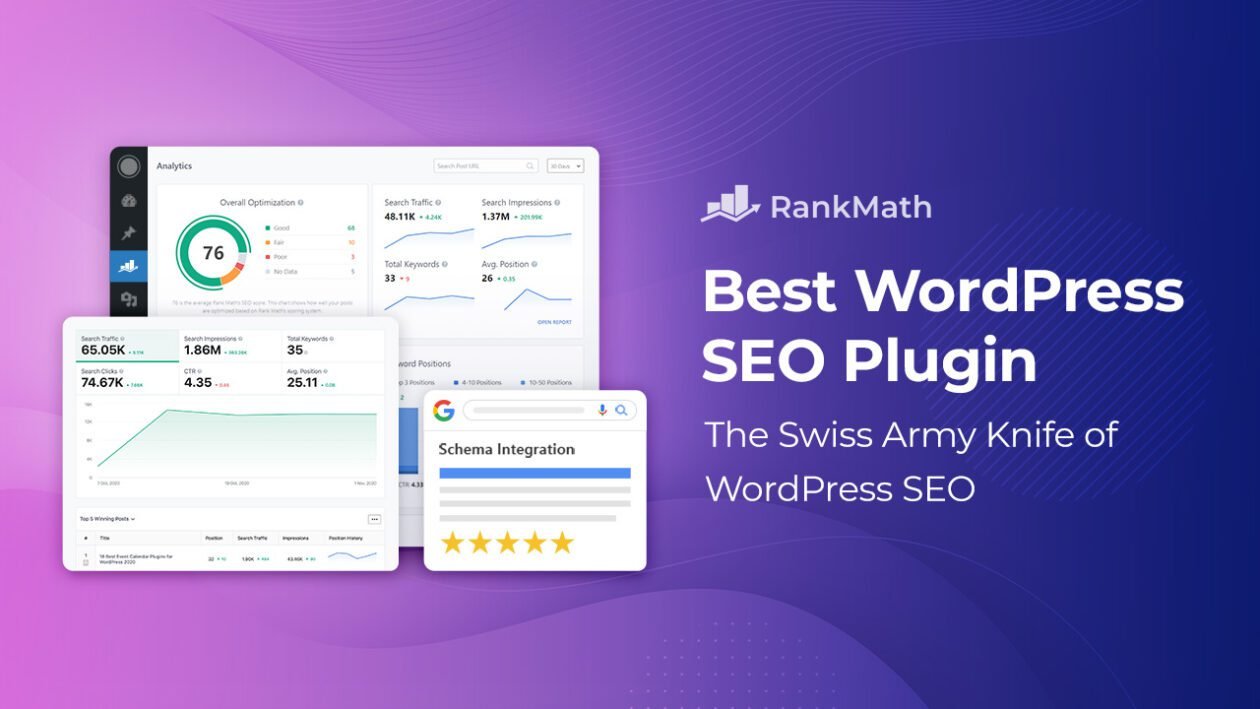
Rank Math is a comprehensive WordPress SEO plugin. It’s designed to make it easy for anyone to optimize their content with built-in suggestions based on widely accepted best practices. It doesn’t matter whether you’re a seasoned SEO professional or a beginner, Rank Math provides a powerful set of tools to increase the search engine visibility of your website.
Here are some key reasons why Rank Math stands out from the pack:
- Easy Setup: Rank Math features a step-by-step installation and configuration wizard that sets up SEO for WordPress perfectly.
- Comprehensive SEO Analysis: Unlike many other plugins that offer limited SEO suggestions, Rank Math provides a detailed analysis based on over 40 known factors.
- User-Friendly Interface: Rank Math’s interface is intuitive and easy to navigate, making it accessible for beginners and experts alike.
- Performance: The Rank Math WordPress plugin is built with performance in mind, ensuring new functionality doesn’t compromise the speed of your website.
- Advanced Features: Rank Math includes advanced features like smart redirection management and internal linking suggestions, which are not commonly found in other plugins.
- Support: Rank Math offers one of the fastest turn-around times for support queries and resolves issues faster and more effectively.
Rank Math can be used for various SEO tasks, including optimizing your titles and descriptions for Google, improving speed and mobile friendliness, and more. It also provides features like meta titles and descriptions, analysis of focus keywords, schema markup, social media descriptions, image SEO, XML sitemap, suggestions for internal linking, breadcrumbs, search console, 404 monitoring, redirects, and WooCommerce SEO.
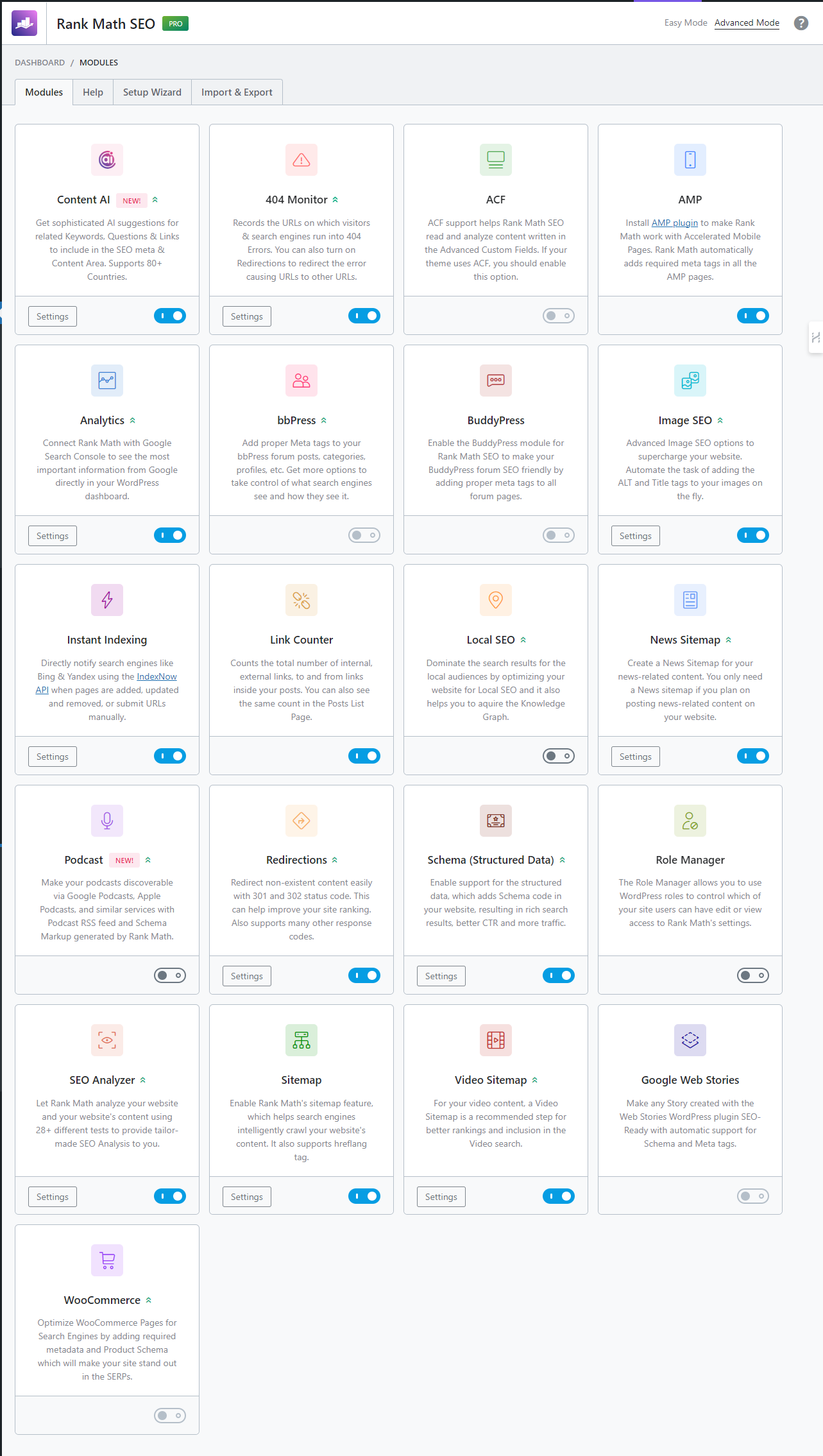
Some of the many benefits of using Rank Math for your website’s SEO strategy include:
- Improved Search Engine Rankings: By optimizing your content and website structure, Rank Math can help improve your website’s rankings in search engine results.
- Increased Organic Traffic: Higher search engine rankings can lead to increased organic traffic to your website.
- Better User Experience: Features like internal linking suggestions can enhance the user experience on your website by making it easier for visitors to find relevant content.
In essence, Rank Math is a powerful tool that helps you optimize your website by analyzing your content and providing recommendations on how to improve your site’s SEO. This can lead to better search engine visibility, increased organic traffic, and improved overall site performance.
So, whether you’re just starting in SEO or looking for an edge over the competition, Rank Math is worth a look.
That being said, let’s now take a deep dive into the 7 powerful Rank Math features that can help you improve your SEO rankings.
Top 7 Rank Math Features to Skyrocket Your Rankings
#1: Rank Math ContentAI
In the last few years, AI writing assistants have become increasingly popular. They can generate high-quality content quickly and efficiently, saving you time and effort. However, these tools can often be expensive and out of reach for many businesses.
This is where Rank Math’s Content AI feature comes in.
ContentAI is a feature in Rank Math that leverages artificial intelligence to help you create SEO-friendly content. It analyzes your content and provides real-time suggestions to improve its SEO value. It even provides insights into keyword usage. This feature is designed to be user-friendly and affordable, making it accessible for businesses of all sizes.
For about a year now, this Rank Math feature has been my go-to tool for content creation and optimization. As you can see in the graphic below even this post was created and optimized using the Rank Math ContentAI feature:
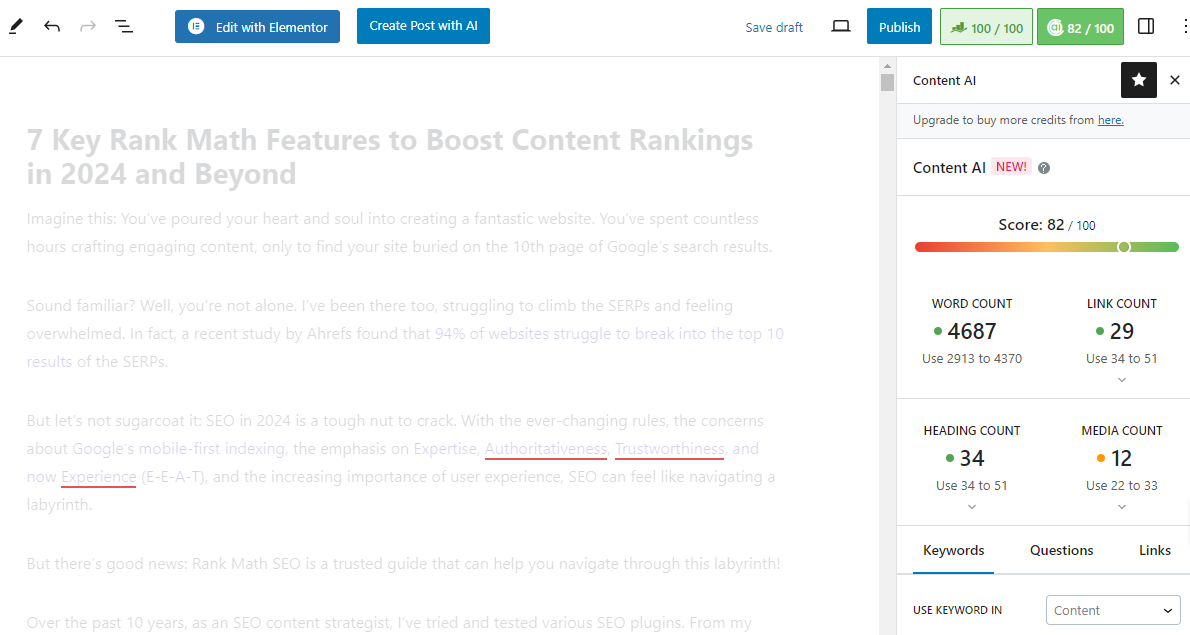
Tips for Using the Content AI Feature
Here are some tips on how to use the Content AI feature effectively:
- Use AI Suggestions: Content AI provides real-time suggestions as you write. Make sure to consider these suggestions to improve the SEO value of your content.
- Focus on Quality: While AI suggestions can be helpful, always prioritize the quality of your content. Remember, your content is meant for humans first, and search engines second.
- Review and Edit: Always review and edit the content generated by AI. While AI can be a great assistant, it’s not perfect. Your human touch can make a big difference.
Impact of Content AI on SEO
Rank Math ContentAI can significantly impact your SEO in several ways:
- Keyword Optimization: ContentAI helps ensure that your content is optimized for the relevant keywords. This can improve your content’s visibility on search engines and increase organic traffic.
- Readability Improvement: By suggesting improvements in sentence structure and tone, ContentAI can enhance the readability of your content, making it more user-friendly.
- Improved Content Quality: By providing real-time suggestions, Content AI can help you create high-quality, SEO-friendly content.
- Content Structuring: Content AI can suggest ways to better structure your content, such as using more headings or bullet points. This can make your content more appealing to both readers and search engines.
- Increased Organic Traffic: High-quality, SEO-friendly content can improve your search engine rankings, leading to increased organic traffic.
- Saved Time and Effort: Content AI can speed up the content creation process, saving you time and effort.
In my experience, using ContentAI has led to noticeable improvements in content quality and SEO performance. For instance, one of my blog posts saw a 20% increase in organic traffic after implementing the suggestions from this Rank Math feature.
Recommended: Rank Math’s Content AI 2.0: A Game-Changer for AI Copywriting? (My Honest Review)
#2: Advanced Schema Markup for Rich Snippets
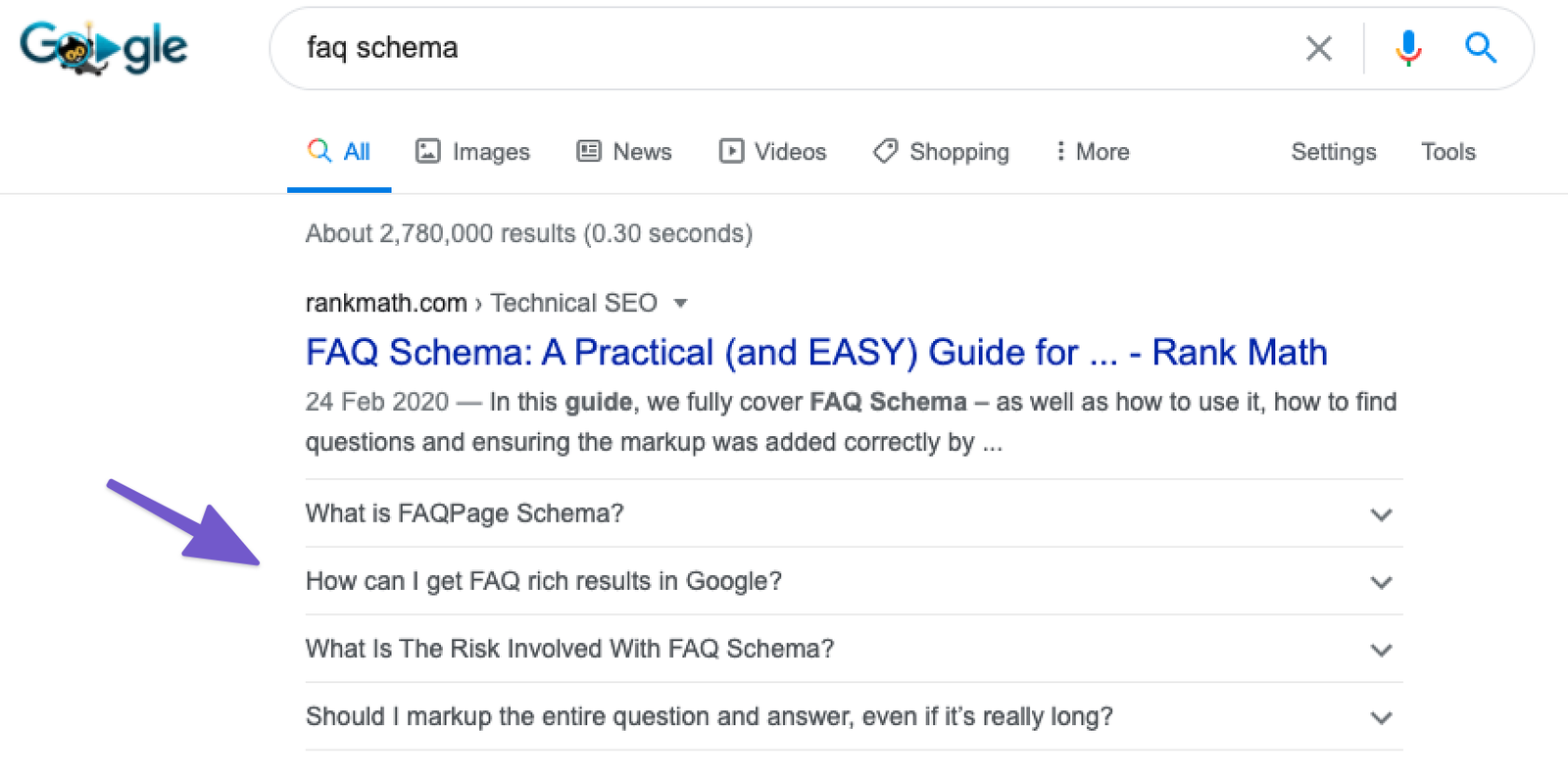
In the ever-evolving world of SEO, rich snippets and Schema markup have become crucial elements for enhancing your website’s visibility on search engine results pages (SERPs).
Rich snippets are search listings that provide additional information about the content of a page. They can include images, ratings, prices, and more. Schema markup, on the other hand, is a form of microdata that helps search engines understand the content on your website. Together, they can significantly enhance your website’s SEO visibility by:
- Increasing Click-Through Rates (CTR): Rich snippets can make your search listing more attractive, potentially increasing the likelihood of users clicking on your link. According to a recent report, pages that show as rich results in search saw an 82% higher click-through rate vs non-rich result pages.
- Improving SERP Rankings: By helping search engines understand your content, Schema markup can improve your website’s ranking on SERPs.
Rank Math offers an Advanced Schema Markup for Rich Snippets feature that simplifies the process of adding Schema markup to your website. With its user-friendly interface and vast schema types, you can easily implement Schema markup without needing to write a single line of code.
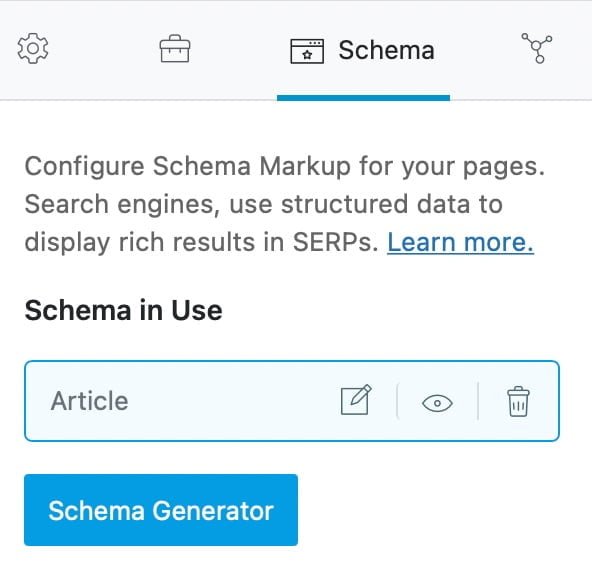
Tips for Using the Advanced Schema Markup for Rich Snippets Feature
Here are some tips on how to use this Rank Math feature effectively:
- Choose the Right Schema Type: Rank Math offers a variety of schema types. Choose the one that best represents your content.
- Fill Out All Relevant Fields: The more information you provide, the better search engines can understand your content.
- Test Your Markup: Use Google’s Structured Data Testing Tool to ensure your markup is implemented correctly.
Impact of the Advanced Schema Markup for Rich Snippets Feature on SEO
Implementing Schema markup using Rank Math can have a significant impact on your SEO. For example:
- Enhanced Search Listings: By adding rich snippets to your search listings, you can make your website stand out on SERPs.
- Improved SEO Visibility: With a better understanding of your content, search engines can display your website for more relevant searches.
- Improved Local SEO: If you’re a local business, schema markup can help you appear in local search results and increase your visibility.
Before I started using Rank Math on my blog, I tried implementing Schema Markup with some other plugin but it was like walking in a dark alley without a touch light! However, once I switched to Rank Math, using Rank Math’s Advanced Schema Markup for Rich Snippets feature was a breeze. I’ve also seen significant improvements in my SEO performance. It’s really that powerful but simple to use!
Recommended: SEO Course by Rank Math: Unleash Your SEO Expertise in 2024 and Beyond!
#3: Rank Math SEO Analytics
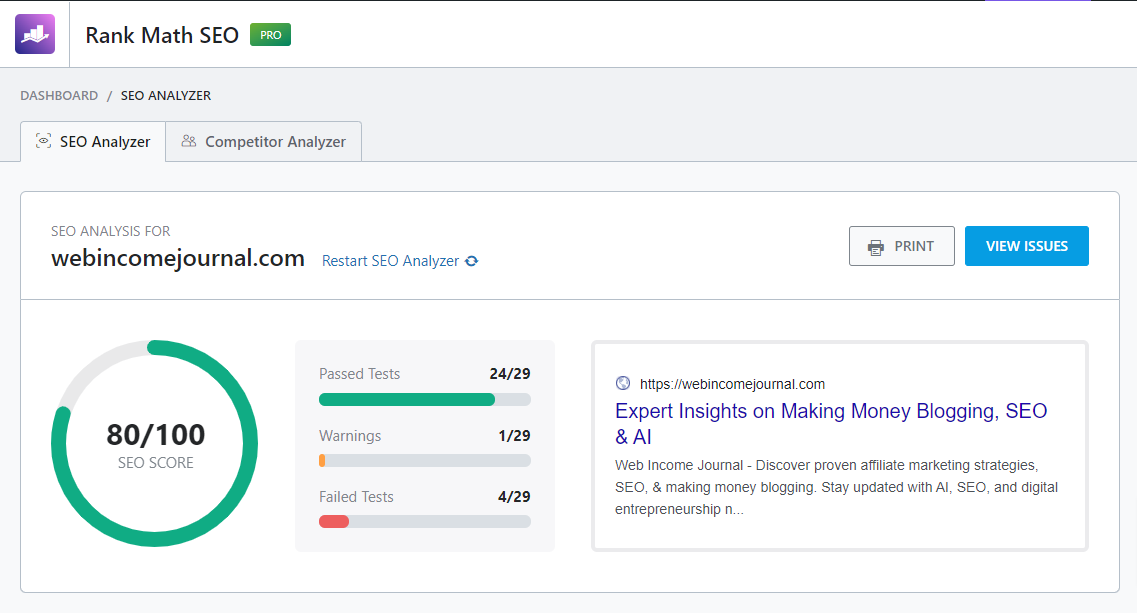
In the world of SEO, data is very important. As the British physicist and mathematician, William Thomson Kelvin, once said,
“What is not defined cannot be measured. What is not measured, cannot be improved. What is not improved, is always degraded”.
This is very true when it comes to search engine optimization. Making data-driven decisions is crucial if you want to make a success of your SEO strategy. This is where Rank Math’s SEO analytics feature comes into play.
SEO Analytics is a Rank Math feature that provides you with valuable insights into your website’s SEO performance. It allows you to track important metrics like keywords, positions, clicks, impressions, and user behavior, all from a built-in dashboard within your WordPress admin area.
Rank Math’s SEO Analytics dashboard is designed to be user-friendly and comprehensive. It provides a bird’s-eye view of your website’s SEO performance, helping you understand how your website is performing in search engine results.
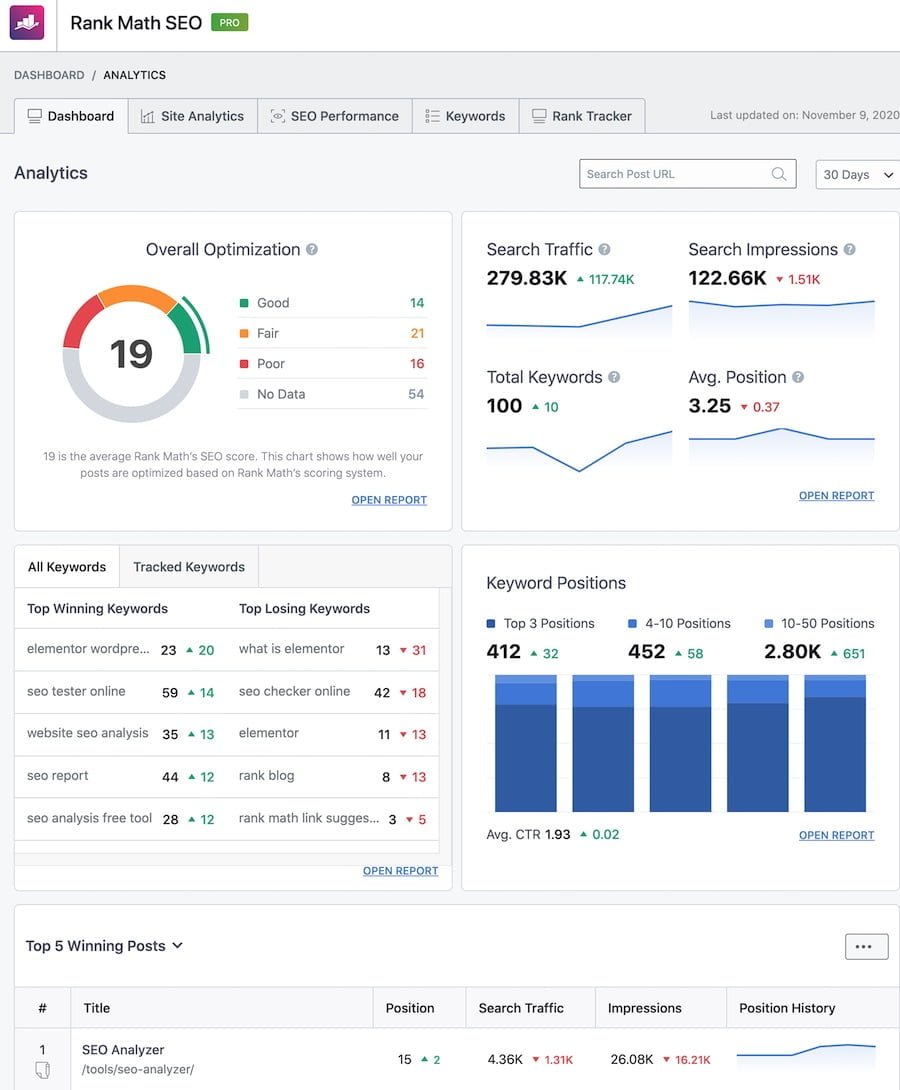
Here are some key features of the dashboard:
- Keyword Tracking: Track the performance of your target keywords over time.
- Position Tracking: Monitor the positions of your website in search engine results for different queries.
- Clicks and Impressions: Understand how often your website appears in search results and how many users click through to your site.
- User Behavior: Gain insights into how users interact with your website, including metrics like bounce rate and average session duration.
How to Use the Rank Math SEO Analytics Feature
Here are some tips on how to use the SEO Analytics feature effectively:
- Monitor Regularly: Regular monitoring can help you spot trends and make timely adjustments to your SEO strategy.
- Analyze Keyword Performance: Use the keyword tracking feature to understand which keywords are driving traffic to your site and focus on optimizing content around those keywords.
- Improve User Experience: Use user behavior data to identify areas of your website that can be improved to enhance user experience and engagement.
- Analyze Your Backlink Profile: Understand who is linking to your website and how. This can help you identify opportunities for link building and detect any potentially harmful backlinks.
Impact of SEO Analytics on SEO
This Rank Math feature can have a significant impact on your SEO. For example:
- Informed Decision Making: By providing you with data about your website’s performance, SEO Analytics can help you make informed decisions about your SEO strategy.
- Improved Keyword Strategy: By tracking your keyword rankings, SEO Analytics can help you refine your keyword strategy and focus on the keywords that are most likely to drive traffic to your website.
- Enhanced Link Building: By analyzing your backlink profile, SEO Analytics can help you identify opportunities for link building and protect your website from potentially harmful backlinks.
- Increased Organic Traffic: By helping you understand and optimize for the keywords that are driving traffic to your site, SEO Analytics can help increase your organic traffic. Over the last few years of using Rank Math, I’ve seen my websites’ SEO performance improve significantly.
Recommended: How to Measure SEO Performance Like a Pro (Even if You’re Just a Beginner)
#4: Powerful Redirects & 404 Management
Broken links and website errors can harm both SEO and the user experience. They can lead to a poor user experience, as users may end up on a page that doesn’t exist or isn’t working properly. This can lead to frustration and may cause users to leave your site. In fact, according to a report, 73.72% of people who reach a 404 error page will leave your website and not return.
From an SEO perspective, broken links can lead to lower rankings, as search engines may see your site as less reliable or poorly maintained.
I must say, of all the Rank Math features discussed in this post, this is the one that caught my attention from the beginning. Before I started using Rank Math, I had a lot of issues with broken links on this blog. This was because I switched webhosts a couple of years ago and had to move the files to the new host. While making the move, I also changed the post’s link structure. This had a lot of effects on the blog for some time because there were a lot of broken links and 404 errors.
It was only after I installed Rank Math and started using it on the site that I was able to find a way around the problem. With the Rank Math Redirection & 404 Management feature, I was able to set up redirects for broken links, monitor 404 errors, and even automate the process of fixing these issues.
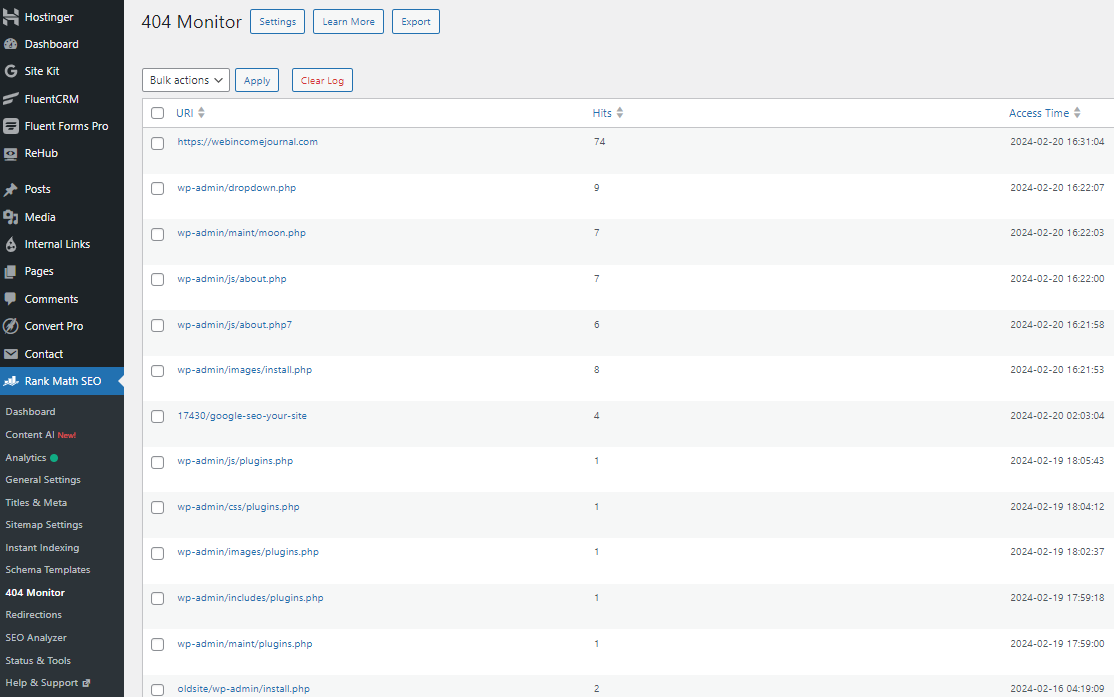
Recommended: Dominate Local Search with Google Business Profile Optimization (The Rank Math Advantage)
How to Use the Redirection & 404 Management Feature
Here are some tips on how to use the Redirection & 404 Management feature effectively:
- Monitor 404 Errors: Use Rank Math’s 404 Monitor to keep track of any 404 errors on your website. This can help you identify broken links and fix them before they impact your SEO or user experience.
- Set up Redirects: If a page on your website has been moved or deleted, set up a redirect to another relevant page. This can prevent users from ending up on a 404 page and keep them engaged with your content.
- Automate the Process: Rank Math allows you to automate the process of setting up redirects and fixing 404 errors. This can save you time and ensure your website is always running smoothly.
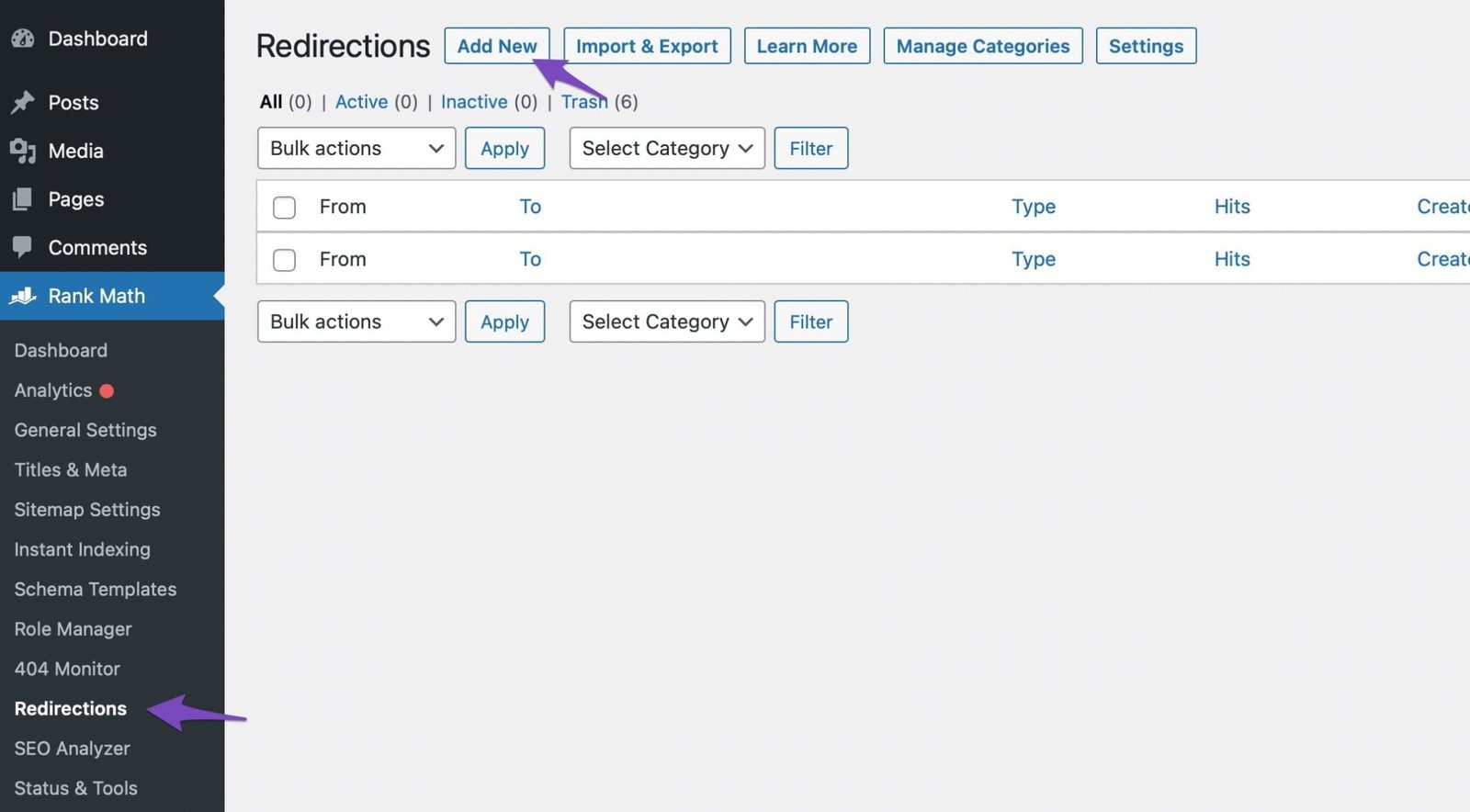
Impact of Redirection & 404 Management on SEO
Effectively managing redirects and 404 errors can significantly impact your SEO in several ways:
- Improved User Experience: By preventing users from ending up on 404 pages, you can provide a better user experience. This can lead to higher engagement and lower bounce rates.
- Better Search Rankings: Search engines prefer websites that are well-maintained and free of broken links. By managing redirects and 404 errors, you can improve your website’s reliability and potentially boost your search rankings.
- Increased Traffic: By redirecting users from broken links to relevant pages, you can keep users on your site longer and potentially increase your traffic.
In my experience, as related above, effectively managing redirects and 404 errors is a great way of improving your website’s performance. Organic traffic has greatly improved since I implemented the redirect and 404 management strategies. The good thing is that Rank Math’s redirects and 404 error management feature will not only help you fix broken links and 404 errors, but it will also help you prevent them from happening in the first place.
Related: Boosting SEO with Google Core Web Vitals in 2024 (A Beginner’s Guide)
#5: Metadata Optimization
Meta titles and descriptions play a crucial role in SEO and click-through rates (CTR). They are the first things users see in search engine results, and compelling meta titles and descriptions can entice users to click on your website.
From an SEO perspective, well-optimized meta titles and descriptions can help search engines understand what your page is about, which can improve your search rankings. And for the user, it’s like creating a compelling advertisement for your website, enticing users to visit and explore your content.
The Metadata Optimization feature in Rank Math allows you to easily edit and optimize your meta titles and descriptions. It provides you with a live preview of how your metadata will appear in search results, allowing you to craft compelling meta titles and descriptions that can improve your CTR.
This is another of the Rank Math features that I use very often in my posts and articles. It makes meta title and description optimization a simple task.

How to Use the Metadata Optimization Feature
Here are some tips on how to use the Metadata Optimization feature effectively:
- Craft Compelling Meta Titles and Descriptions: Your meta titles and descriptions should be compelling and accurately represent the content of your page. They should entice users to click on your website in search results.
- Use Your Keywords: Include your target keywords in your meta titles and descriptions. This can help search engines understand what your page is about and can improve your search rankings.
- Keep It Concise: Your meta titles and descriptions should be concise and to the point. Search engines typically truncate meta titles and descriptions that are too long, so it’s important to keep them within the recommended length.
POWER TIP: You can use the ContentAI feature to craft highly optimized meta titles and descriptions. As mentioned earlier, this feature leverages artificial intelligence, and it’s great for creating SEO-friendly content.

Impact of Metadata Optimization on SEO
Metadata optimization can significantly impact your SEO in several ways:
- Improved Click-Through Rate: Compelling meta titles and descriptions can entice users to click on your website in search results, which can improve your CTR.
- Better Search Rankings: Well-optimized meta titles and descriptions can help search engines understand what your page is about, which can improve your search rankings.
- Increased Traffic: By improving your CTR and search rankings, metadata optimization can potentially increase your website’s traffic.
Remember, the goal is not just to optimize your metadata, but to create compelling meta titles and descriptions that can entice users to visit your website.
Recommended: SEO Copywriting Checklist: 6 Proven Strategies for Crafting Content that Ranks and Drives Traffic
#6: Internal Linking
As an experienced SEO content writer, I can’t stress enough the importance of internal linking. It’s a powerful tool that can significantly improve your website’s structure, SEO, and user experience. Even Google’s John Mueller affirms this fact. According to him, internal linking is,
“One of the biggest things that you can do on a website to kind of guide Google and guide visitors to the pages that you think are important.”
But what is internal linking?
It’s the process of creating links between different pages on your website. Internal links connect your content and give Google an idea of the structure of your website. They can establish a hierarchy on your site, allowing you to provide the most important pages and posts with more link value than other, less valuable pages.
Internal links serve three main purposes:
- Website Structure: Internal links help in organizing your website content hierarchically, making it easier for users to navigate and find relevant information.
- SEO: Search engines use internal links to understand the content and structure of your website, which can improve your site’s visibility in search engine results.
- User Experience: By linking related content together, you can guide your visitors to more relevant information, enhancing their overall experience on your site.
Rank Math offers a robust Internal Linking feature. This feature automatically suggests relevant links for your article based on the marked pillar links, selected categories, and tags. With this feature, you don’t have to manually search for and pick relevant links to use in your content.
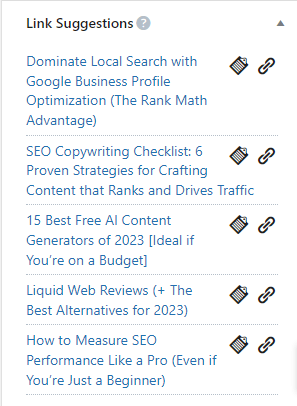
How to Use the Internal Linking Feature
Here are some tips on how to use the Internal Linking feature effectively:
- Relevance: Ensure that the internal links you add are relevant to the context of your content.
- Balance: Avoid excessive internal linking. Too many links can distract and confuse your readers.
- Anchor Text: Use descriptive anchor text for your internal links to provide clear cues about the linked content.
Impact of Internal Linking on SEO
Proper use of the Internal Linking feature can have a significant impact on your SEO. For instance, a well-structured website with strategic internal linking can lead to:
- Improved Indexing: Search engines can index your site more efficiently, leading to better visibility.
- Link Equity Distribution: Internal links distribute link equity across your site, potentially improving the ranking of linked pages.
- Lower Bounce Rates: By guiding visitors to related content, you can keep them engaged longer, reducing bounce rates.
Remember, while internal linking is a powerful SEO tool, it’s just one piece of the puzzle. Consistently creating high-quality, relevant content is equally, if not more, important.
Related: How to Build High Authority Backlinks for SEO and Traffic with HARO
#7: Automatic SEO Image Optimization
In my years of experience as an SEO content strategist, I’ve found that image optimization is a critical, yet often overlooked, aspect of SEO. It plays a significant role in website loading speed, SEO ranking, and accessibility.
Image optimization involves reducing the file size of your images without sacrificing quality so that your page load times remain low. It’s also about getting your product images and decorative images to rank on Google and other image search engines. It will interest you to know that recent statistics show that an astounding 22.6% of all internet searches are made through Google Images.
Here are some reasons why image optimization is important:
- Website Loading Speed: Large, unoptimized images account for 75% of total page weight. This can slow down your website, leading to a poor user experience.
- SEO Ranking: Search engines, like Google, factor in page load speed as a ranking signal. Optimized images can help improve your SEO ranking.
- Accessibility: Properly optimized images with good alt text can improve accessibility for people who use screen readers.
The Rank Math image optimization feature makes it easy to optimize your images for SEO. This feature helps you add SEO-friendly alt text, titles, and descriptions to your images.
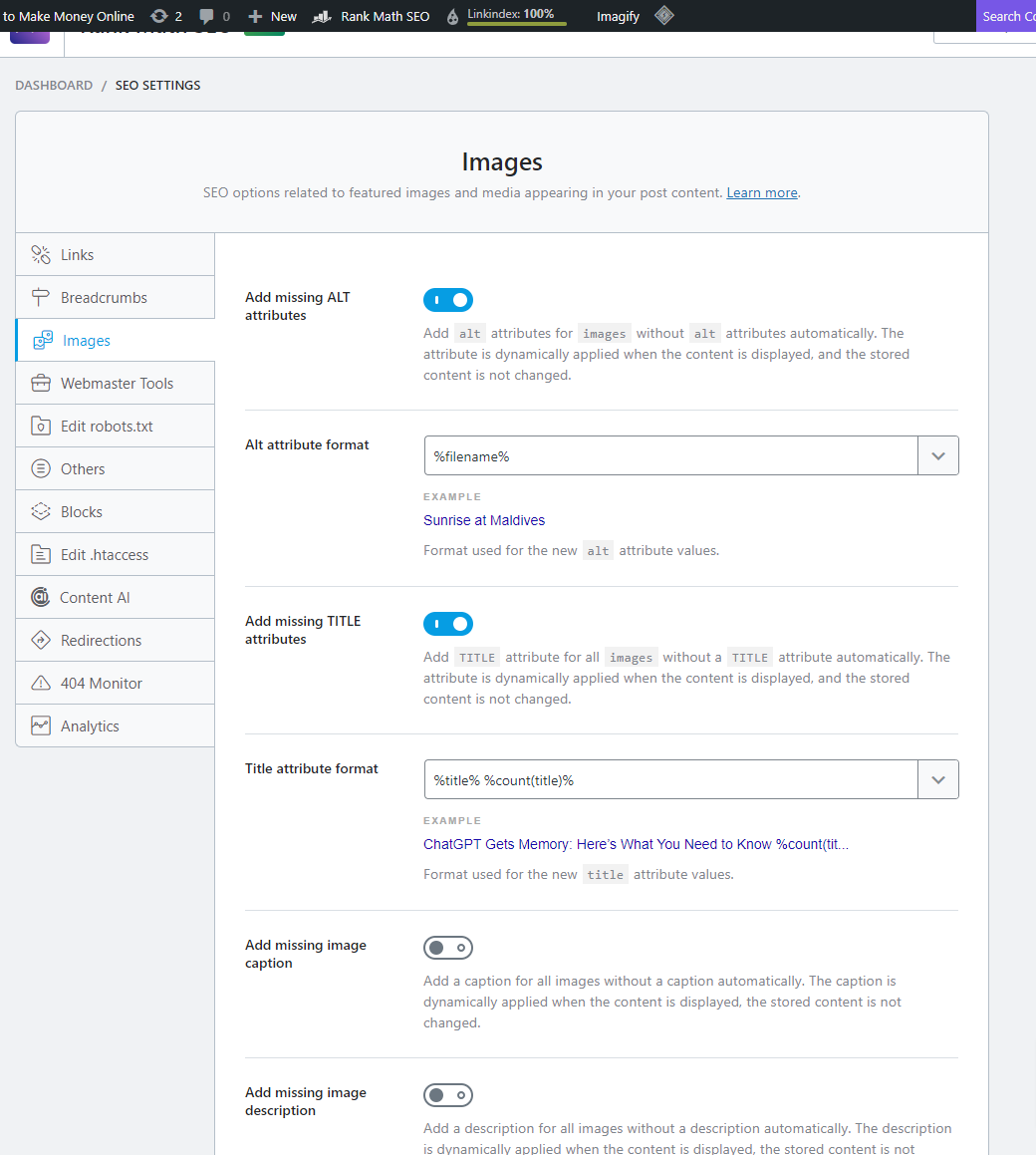
How to Use the Image Optimization Feature
Here are some tips on how to use the Image Optimization feature effectively:
- Alt Text: Always include descriptive alt text for your images. This helps search engines understand what the image is about.
- File Size: Try to reduce the file size of your images without compromising on quality. Smaller file sizes lead to faster page load times.
- File Name: Use descriptive file names for your images. This can help search engines understand your image content.
Impact of Image Optimization on SEO
Proper image optimization can have a significant impact on your SEO. For example:
- Improved Page Load Speed: Optimized images load faster, leading to improved page load speed and a better user experience.
- Better Rankings: By improving page load speed and providing search engines with relevant information about your images, you can potentially improve your website’s SEO rankings.
- Increased Traffic: Images optimized for SEO can appear in image search results, potentially driving more traffic to your site.
Remember, image optimization is just one part of a comprehensive SEO strategy. It’s important to also focus on other aspects like content quality, keyword optimization, and backlinks.
Recommended: How to Use AI for SEO Optimization: A Comprehensive Guide
Conclusion
There you have it: the 7 powerful Rank Math features that can skyrocket your content rankings in 2024 (and beyond). These are just a few selected Rank Math features. There are a plethora of other valuable features, all designed to improve your website’s SEO performance. With Rank Math, you’re in control because it makes SEO tasks more manageable and less time-consuming.
I encourage you, therefore, to try Rank Math and explore its power for yourself. With its free version and affordable Pro version, Rank Math is accessible to users of all budgets. Whether you’re a seasoned SEO professional or a beginner, Rank Math has something to offer you.
But you don’t have to take my word for it; you can try it out for yourself today and see the difference these Rank Math features can make. Remember, every journey begins with a single step. So, why not get started today with that first step by exploring the powerful Rank Math features for yourself?
Click here to get started for free today. It’s your turn to experience the power of Rank Math!
FAQs: Rank Math Features
-
Is Rank Math good for SEO?
Yes, Rank Math is a comprehensive and valuable tool for SEO. It offers a wide range of features like on-page optimization, keyword tracking, competitor analysis, technical SEO audits, and rich snippets generation. While SEO success involves more than just using a plugin, Rank Math can be a powerful asset in your optimization strategy.
-
Is Rank Math plugin free?
The core Rank Math plugin is completely free to use, making it a great option for beginners and budget-conscious website owners. They also offer a Pro version with additional features like unlimited keyword tracking and project management.
-
Is Rank Math better than Yoast?
“Better” is subjective and depends on your individual needs. Both Rank Math and Yoast SEO are popular plugins with their own strengths and weaknesses. Rank Math generally offers more features in the free version, while Yoast might have a slightly simpler interface for beginners. Research and compare both options before making a decision.
-
Is Rank Math only for WordPress?
Yes, currently Rank Math is only available as a plugin for WordPress websites
-
What is the difference between Rank Math and SEOpress?
Both Rank Math and SEOpress are SEO plugins for WordPress, offering similar features like on-page optimization and keyword tracking. Key differences include Rank Math having a larger user base and more features in the free version, while SEOpress offers a unique content analysis tool and might be considered slightly easier to use.
-
Can I rank a website without SEO?
Technically, yes, your website might appear in search results without actively focusing on SEO. However, achieving good rankings and attracting significant organic traffic usually requires dedicated SEO efforts. Tools like Rank Math can help you optimize your website and increase your chances of ranking higher.
-
How do I choose the right schema type for my content?
Several schema markup options exist, each tailored to different content types. Research and choose the schema type that most accurately reflects the nature of your content (e.g., article, recipe, product). Rank Math can recommend suitable schema types based on your content.
-
What is the importance of data-driven decisions in SEO?
SEO is constantly evolving, and relying solely on intuition can lead to ineffective strategies. Data-driven decisions based on accurate insights from tools like Rank Math’s SEO Analytics help you understand what works and what doesn’t, allowing you to optimize your efforts with confidence.
-
What is the difference between Google Analytics and Rank Math’s SEO Analytics tool?
Google Analytics provides broader website traffic and audience insights, while Rank Math’s SEO Analytics focuses specifically on SEO-related data like keyword rankings, backlinks, and organic traffic sources. Both tools offer valuable information, but serve different purposes. Use them in conjunction for a comprehensive understanding of your website’s performance.






“This is such a helpful overview of Rank Math! The features you highlighted are essential for anyone looking to improve their content rankings. I’m particularly interested in how the schema markup works—could you share more about its impact on SEO? Thanks for sharing these insights!”